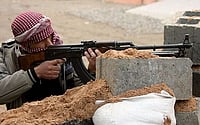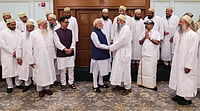The 21 months under Emergency—from June 25, 1975, to March 21, 1977—were considered the ‘darkest period’ for the Indian press. Prime Minister Indira Gandhi suspended freedom of speech and imposed restrictions against media outlets censoring news that could cause disturbances. Some newspapers rebelled and ran blank editorials as protests, or published enduring quotes of freedom fighters; the others filled empty news slots with frivolous items like recipes on onion raita.
But the doyen of Indian newspapers, the Gujarati news daily Mumbai Samachar, remained unscathed from the censorship storm. It was the only major newspaper in Western India to be exempted from restrictions and functioned routinely.
Started in 1822 by Parsi scholar and entrepreneur Furdoonjee Marzbanjee and presently owned by the Cama family since 1933, it is the oldest continuously published news daily in Asia.
Housed in the iconic Red House brick building at the Horniman Circle, Mumbai Samachar has borne witness to all the historical events of the last two centuries. From the death of Rani Laxmi Bai and the end of the East India Company's rule in 1858 to the outbreak of the First World War in 1914, the atomic bombings of Hiroshima and Nagasaki in 1945 and the assassination of Mahatma Gandhi in 1948, to the fall of Babri mosque in 1992 and election of Narendra Modi as Prime Minister in 2014—the newspaper’s brittle yellow copies with faded ink have covered it all.
Mumbai Samachar had a history of over 175 years of reporting national and international news when the Indira Gandhi government prohibited the publishing of news without government consent.
The newspaper had built a stern reputation for being, ‘nishpaksh’ or impartial. Its editorial line was neither pro or anti-government. It reported news for what it was, as factual events.
“Mumbai Samachar always maintained impartiality; it never took the side of any government. During the Emergency period, the owner and managing director of the newspaper, Nusserwanji Cama, conveyed the same to PM Gandhi,” says Nilesh Dave, the current editor. “He informed the government that newspapers were an important medium of communication with the public at large. Any kind of censorship would cut this crucial communication and result in a dangerous situation. It was important to report facts.”
Dave emphasises that print media outlets, including small journals and periodicals by Gandhian activists established before the country’s independence in 1947, were infallible in their attempt to question the powers to be. And Mumbai Samachar was no different. Its owners, like many other news publishers, refused to obey the government’s orders without putting up a fight.
Mahendra Punatar, 86, one of the three news editors on duty during the Emergency period at Mumbai Samachar recalled sending page proof to the State Press Advisor appointed by the Maharashtra government at the Mantralaya. The State Censorship Order required editors of all newspapers, periodicals, pamphlets and other documents to submit for scrutiny by the authorities
“Before publishing the news, especially the editorial page, we were required to send the proof to the advisor who acted as a censorship officer. They would scrutinise all the news and check the page proof for any sensitive articles that could cause public disturbances.”
Mumbai Samachar followed this routine for a week after the Emergency was declared. “Our newspaper did not face many restrictions as we did not report against anyone,” says Punatar.
Two other publications in Western India—Freedom First, published from Bombay by politician Minoo Masani, and Ahmedabad-based Bhoomiputra published by activist Chunibhai Vaidya—challenged the censorship order in the Bombay and Gujarat High Court and won the case.
The environment in Bombay was, however, fearful among the rest of the print media fraternity, as journalists could not publish any news deemed to be against the government. There was fear among the journalists of talking in public and getting arrested for heresy.
The central government expelled foreign correspondents and withdrew the accreditations of several national reporters, cartoonists and photographers. A total of 258 journalists, including prominent and senior journalists, were imprisoned under the Maintenance of Internal Security Act (MISA).
The government controlled the dissemination and publication of all news on print, radio and television. Government advertisements were withheld from newspapers who would violate the guidelines.
The only good thing out of emergency, Punatar says lightly, was the overall discipline and improved efficiency in public services. “All government offices functioned effectively. There were no delays in getting work done. Even the local trains ran on time.”
Mumbai Samachar survived the storms of the Emergency and thrived on its reputation of facts and impartiality. In 2022, it completed 200 years of publication. The newspaper is revered among the city’s Gujarati and the trading community who vouch for its accuracy: if it is published in Mumbai Samachar, then it must be true, is the adage of its readers.
Fifty years ago, Mumbai Samachar was a national daily and had circulation from Kashmir to Kanyakumari. With the onslaught of digital news, its publishers closed circulation outside the city owing to high air prices.
Strikingly, it commands a circulation of 80,000 copies in the Mumbai metropolitan area alone, even when it is priced at Rs 10, making it a high-value regional language newspaper.
The one thing that has remained constant in the newspaper’s 203-year-long journey is its impartiality, says editor Dave beaming with pride. “Our ideology is to retain facts, and we have remained loyal to it. As a newspaper, we are not here to pass judgements, appease the authorities or publish half-baked news articles. It doesn’t mean we don’t criticise the government in power.”
As proof, Dave points out the critical coverage of the BJP government’s actions and policies on the front page of the newspaper days ahead of Prime Minister Narendra Modi’s visit to Mumbai Samachar’s bicentennial celebrations in the city in June 2022. As well as the recent visit of Home Minister Amit Shah for the release of Mumbai Samchar’s documentary Mumbai Samachar—200 Not Out.
“We are janta’s newspaper, and it is crucial that we maintain their trust by reporting real and factual news,” Dave says. “In all these years, we never faced any defamation case for fake news or had to retract any news item for factual inaccuracies or apologise to our readers for errors. That remains our biggest achievement to date,” he says.


























